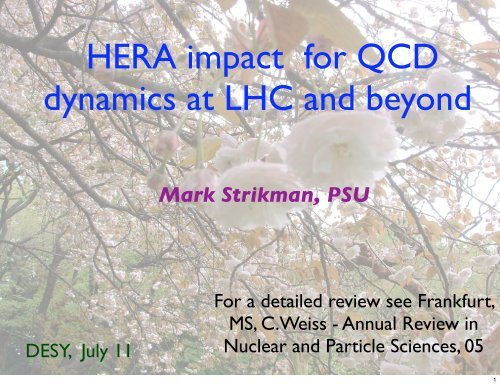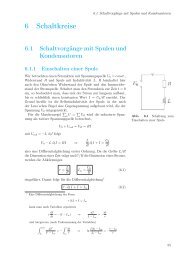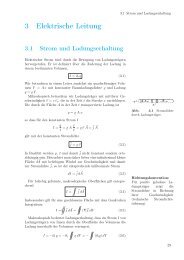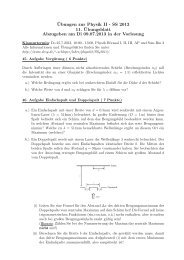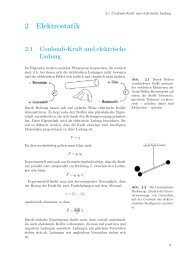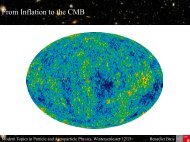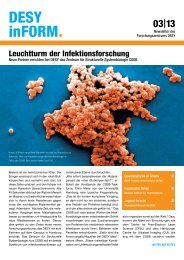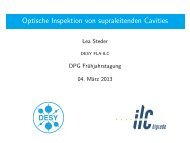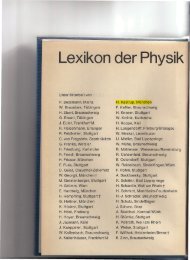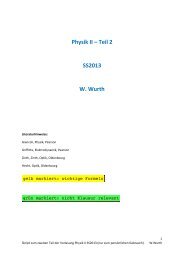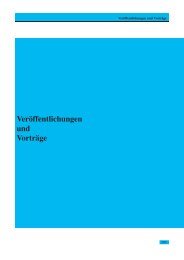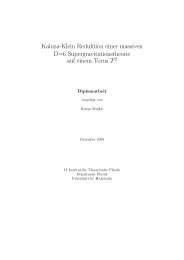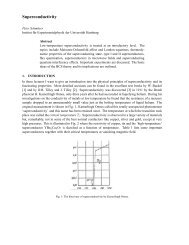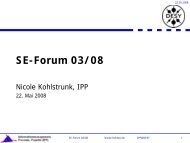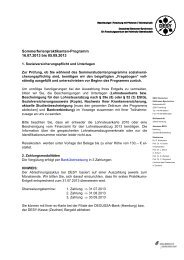Transparencies pdf - Desy
Transparencies pdf - Desy
Transparencies pdf - Desy
You also want an ePaper? Increase the reach of your titles
YUMPU automatically turns print PDFs into web optimized ePapers that Google loves.
HERA impact for QCD<br />
dynamics at LHC and beyond<br />
DESY, July 11<br />
Mark Strikman, PSU<br />
For a detailed review see Frankfurt,<br />
MS, C.Weiss - Annual Review in<br />
Nuclear and Particle Sciences, 05<br />
1
Goal for LHC - realistic account of the transverse structure of the<br />
nucleon and of the onset of Black Disk Limit on the global structure<br />
of the events with Higgs, SUSY,...<br />
For inclusive cross section at high virtuality transverse<br />
structure does not matter - convolution of parton densities<br />
For multiple collisions - which have large probability at LHC - rates<br />
scale as 1/(transverse area occupied by partons), depend on the shape of<br />
the transverse distribution and on the degree of the overlap<br />
Current MC’s of pp collisions at LHC/ Tevatron do not<br />
include constrains on the transverse structure of the<br />
nucleon originating from HERA studies.<br />
2<br />
2
Outline<br />
• Imaging a fast nucleon.<br />
• Onset of black regime of interaction for small<br />
dipoles<br />
• Centrality trigger for pp collisions.<br />
• Forward hadron production - LHC & cosmic<br />
rays<br />
3<br />
3
Image of nucleon at different resolutions, q. Rest frame.<br />
resolution 1 fm, q < 300 MeV/c<br />
+ + ...<br />
q ¯q pair in π<br />
q > 1000 MeV/c<br />
1000 > q > 300 MeV/c<br />
Constituent quarks, pions (picture inspired<br />
by chiral QCD)<br />
pQCD evolution<br />
4<br />
resolution 1/3 fm<br />
4
Image of nucleon at different resolutions, q. Fast frame.<br />
Energy dependence of the transverse size of small x partons.<br />
R 2 (n) ≈ n<br />
k 2 t0<br />
(a) (b)<br />
1<br />
2<br />
3<br />
4<br />
(c) longitudinal momentum transverse coordinate<br />
l coh<br />
Random walk in b-space (Gribov 70). (Drunken sailor walk)<br />
5<br />
d<br />
3<br />
2<br />
1<br />
4<br />
5
Length of the walk rapidity, y as each step a change in rapidity of few units<br />
Implications:<br />
∝<br />
n ∝ y =⇒ R 2 = R 2 0 + cy ≡ R 2 0 + c ′ lns<br />
(a) The transverse size of the soft wee parton cloud should logarithmically grow wit<br />
energy.<br />
Logarithmic increase of the t-slope of the elastic hadron-hadron scattering<br />
amplitude with energy:<br />
f (t) ∝ exp(Bt/2), B(s) = B0 + 2α ′ ln(s/s0)<br />
α ′ ∝ 1/k 2 t0<br />
6<br />
6
z-x cut of the fast nucleon<br />
the rate of increase of transverse size with x decreases with increase of<br />
the resolution scale<br />
transverse size of the parton cloud<br />
Momentum P in z direction<br />
→<br />
< x ><br />
z = rN<br />
xP<br />
→<br />
wee parton are spread over 1 fm even at high energies<br />
7<br />
Transverse size of x>0.1 quarks<br />
and gluons is smaller than the<br />
average proton size predominantly<br />
due to the pion cloud effects -<br />
Frankfurt, MS, Weiss<br />
- will discuss later<br />
7
long.momentum/transverse Image at High resolution<br />
Gribov diffusion is much weaker as the transverse momenta in most of the decay<br />
ladder are much larger than the soft scale. Transverse size shrinks with increase of<br />
resolution scale!!! No analogous effect in classical mechanics (brain images).<br />
Evidence: α for the process<br />
′<br />
γ + p → J/ψ + p<br />
is smaller than for soft processes by a factor of two.<br />
Additional important effect: transverse distribution of x≥.05<br />
gluons in the nucleon is significantly smaller than a naive guess<br />
based on the e.m. radius of the nucleus.<br />
Confirms our prediction of 94 - BFGMS<br />
8<br />
8
Implication - hard processes correspond to collisions where nucleons overlap<br />
stronger & more partons hit each other - use hard collision trigger to study<br />
central collisions/ all new physics LHC craves to discover corresponds to central<br />
pp collisions.<br />
soft<br />
hard<br />
"peripheral"<br />
(dominate total<br />
cross section)<br />
b<br />
9<br />
hard dijet<br />
q T = 100 GeV<br />
x 1<br />
x 2<br />
x1,2 = 2 / W ~ 10 −2<br />
q<br />
T<br />
"central"<br />
b<br />
9
To quantify the difference of the impact parameters and the role of small x<br />
gluon field we can use theoretical analyses of the hard phenomena studied<br />
at HERA:<br />
● Determination of the transverse distribution of gluons.<br />
● Strength of of “small dipole”-nucleon interactions at<br />
high energies<br />
11<br />
11
)'
dσ<br />
dt<br />
2α(t)−1 s<br />
= f (t)<br />
s0<br />
:;;&75?&@5) A@3B&7
Binkley et al<br />
.9:%);3*7:?3:4#@&3;<br />
DD<br />
D! !!<br />
A95=5A:54C7=%5)<br />
'9:%);3*&#'&&)#%)#! A:54"<br />
&(&7=:5A:54C7=%5)<br />
43=3#A5%)=#
longitud.<br />
"<br />
hard<br />
GPD<br />
t<br />
transverse<br />
xP<br />
J/!<br />
", #<br />
exclusive<br />
x<br />
17<br />
17
2! " F g (x, ", Q 2 ) / fm -1<br />
2<br />
1<br />
0<br />
Q 2 / GeV 2 = 3<br />
10 2<br />
0 1 2<br />
" / fm<br />
10 6<br />
x = 10 -3<br />
The change of the normalized ρ–profile of the gluon distribution,<br />
Fg(x, ρ; Q 2 ), with Q 2 , as due to DGLAP evolution, for x = 10 −3 . The<br />
input gluon distribution is the GRV 98 parameterization at Q 2 0 = 3 GeV 2 ,<br />
with a dipole–type b–profile.<br />
19<br />
M.Strikman<br />
19
fm 2<br />
0.45<br />
0.4<br />
0.35<br />
0.3<br />
1 10 2<br />
x = 10 -2<br />
10 -3<br />
10 -4<br />
10 4<br />
Q 2 / GeV 2<br />
10 6<br />
Change of with x due to<br />
DGLAP evolution - leads to effective α´<br />
which drops with Q but still remains<br />
finite even at very high Q.<br />
The change of the average transverse gluonic size squared, 〈ρ 2 〉, due to<br />
DGLAP evolution, for x = 10 −2 , 10 −3 and 10 −4 .<br />
20<br />
M.Strikman<br />
20
Experimentally one measures the ratio<br />
where f (x1,x3), f (x2,x4) longitudinal light-cone double parton densities and<br />
σe f f<br />
dσ(p+ ¯p→ jet1+ jet2+ jet3+γ)<br />
dσ(p+ ¯p→ jet1+ jet2)<br />
dΩ1,2<br />
dΩ1,2,3,4<br />
· dσ(p+ ¯p→ jet3+γ)<br />
dΩ3,4<br />
is ``transverse correlation area''.<br />
CDF observed the effect in a restricted x-range: two balanced jets, and jet + photon<br />
+ 1.7<br />
and found σe f f = 14.5 ± 1.7 − 2.3 rather small - a naive expectation is<br />
σe f f ~ 60 mb indicating high degree of correlations between partons in the nucleon<br />
in the transverse plane. No dependence of σe f f on xi was observed.<br />
mb<br />
22<br />
=<br />
f (x1,x3) f (x2,x4)<br />
σe f f f (x1) f (x2) f (x3) f (x4)<br />
22
☺<br />
☺<br />
☺<br />
Possible sources of small σe f f for CDF kinematics<br />
of x ~0.1-0.3 include:<br />
Small transverse area of the gluon field --accounts for 50 % of the<br />
enhancement σeff ~ 30mb (F&S & Weiss 03)<br />
Constituent quarks - quark -gluon correlations (F&S&W)<br />
If most of gluons at low Q~ 1GeV scale are in constituent quarks of radius<br />
rq/rN ~1/3 found in the instanton liquid based chiral soliton model<br />
(Diakonov & Petrov) the enhancement as compared to uncorrelated parton<br />
approximation is<br />
8<br />
9<br />
+ 1<br />
9<br />
r 2 N<br />
r 2 q<br />
∼ 2<br />
Hence, combined these two effects are sufficient to explain CDF data.<br />
(F&S&W)<br />
QCD evolution leads to “Hot spots” in transverse plane (A.Mueller). One<br />
observes that such hot spots do enhance multijet production as well.<br />
However this effect is likely not to be relevant in the CDF kinematics as x’s<br />
of colliding partons are relatively large.<br />
23<br />
23
In order to analyze the strengths of interaction with the gluon fields at<br />
small x it is convenient to consider virtual photon - nucleon scattering in<br />
the nucleon rest frame.<br />
Space-time picture of DIS, exclusive vector meson<br />
production - a three step process:<br />
● transition γ ∗ → h where h are various<br />
configurations long before the target:<br />
●<br />
●<br />
lcoh ∼ c(Q 2 )q0/Q 2 ,c(Q 2 ) ≤ 1<br />
Slow evolution of this wave package.<br />
q ¯q,q ¯qg...<br />
interaction of the evolved configurations with the target,<br />
formation of the final state.<br />
24<br />
24
Convenient to introduce a notion of the cross section of the interaction of a<br />
small dipole with the nucleon. Such a cross section can be legitimately<br />
calculated in the leading log approximation. One can also try to extend it to<br />
large size dipoles hoping that a reasonably smooth matching with<br />
nonperturbative regime is possible. Sensitive to mq in nonperturbative<br />
regime - real photon size constrain → mq ~ 300 MeV for u & d quarks.<br />
A delicate point: in pQCD the cross section depends both on the<br />
transverse separation between quark and antiquark and the off-shellness<br />
(virtuality) of the probe which produced the q ¯q pair. In most of the models<br />
on the market this is ignored.<br />
25<br />
25
Consider first “small dipole - hadron” cross section<br />
d<br />
σinel = π2<br />
3 F2 d 2 αs(λ/d 2 )xGT(x.λ/d 2 )<br />
F 2 Casimir operator of color SU(3)<br />
F 2 F 2<br />
(quark) =4/3 (gluon)=3<br />
Comment: This simple picture is valid only in LO. NLO would require<br />
introducing mixing of different components. Also, in more accurate expression<br />
there is an integral over x, and and extra term due to quark exchanges<br />
26<br />
Baym et al 93<br />
26
HERA data confirm increase of the cross sections of small<br />
dipoles predicted by pQCD<br />
2<br />
(d , x, Q ) (mb)<br />
qqN<br />
−<br />
!<br />
45<br />
40<br />
35<br />
Hard 30<br />
Regime<br />
25<br />
20<br />
15<br />
10<br />
5<br />
0<br />
0<br />
"<br />
"<br />
0.1<br />
Matching Region<br />
= 4 x = 0.0001<br />
= 10<br />
0.2<br />
0.3<br />
0.4<br />
0.5<br />
d (fm)<br />
0.6<br />
x = 0.001<br />
x = 0.01<br />
The interaction cross-section, ˆσ for CTEQ4L, x = 0.01, 0.001, 0.0001,<br />
λ = 4, 10. Based on pQCD expression for ˆσ at small dt, soft dynamics at<br />
large b, and smooth interpolation. Provides a good description of F2p at<br />
HERA and J/ψ photoproduction.<br />
Frankfurt, Guzey, McDermott, MS 2000-2001<br />
0.7<br />
0.8<br />
Provided a reasonable prediction for σL<br />
27<br />
Soft<br />
Regime<br />
0.9<br />
1<br />
27
Impact parameter distribution in “h”(dipole)p interaction<br />
Study of the elastic scattering allows to determine how the strength of the<br />
interaction depends on the impact parameter, b:<br />
Z<br />
Γh(s,b) = 1<br />
2is<br />
Z<br />
σtot = 2<br />
σel =<br />
σinel =<br />
Note that elastic unitarity:<br />
1<br />
(2π) 2<br />
Z<br />
Z<br />
d 2 qe iqb AhN(s,t)<br />
d 2 bReΓ(s,b)<br />
d 2 b|Γ(s,b)| 2<br />
d 2 b(1 − (1 − ReΓ(s,b)) 2 − [ImΓ(s,b)] 2<br />
Γ(b) = 1 ≡ σinel = σel<br />
- black disk limit -BDL<br />
; ImA = sσtot exp(Bt/2)<br />
1<br />
2 ImA = |A|2 + ... allows Γ(b) ≤ 2<br />
)<br />
28
Using information on the exclusive hard processes we can also estimate t-dependence<br />
of the elastic dipole-nucleon scattering and hence estimate<br />
Γq ¯q f rom σ(q ¯qN).<br />
In the case gg-N scattering we assume pQCD relation<br />
Γ Γ Γ<br />
Γ Γqq<br />
Γgg<br />
1<br />
0.5<br />
0<br />
qq<br />
0 0.5<br />
x = 10 −2<br />
x = 10 −3<br />
x = 10 −4<br />
x = 10 −5<br />
d = .1 (fm)<br />
gg<br />
0.5<br />
1<br />
qq<br />
1 0.5<br />
1<br />
b (fm) 0<br />
b (fm) 0<br />
1<br />
0 0.5 1<br />
0 0.5<br />
d = .3 (fm)<br />
29<br />
gg<br />
0.5<br />
1<br />
0.5<br />
Γgg = 9<br />
d = .5 (fm)<br />
4 Γq ¯q<br />
1<br />
1<br />
0.5<br />
b (fm)<br />
29
Can use hard diffraction<br />
to check proximity to BDL<br />
g, q, q −<br />
x P<br />
H<br />
t<br />
M X<br />
Hard scattering<br />
process<br />
Diffractive<br />
parton<br />
distribution<br />
QCD factorization theorem for diffractive processes consistent with<br />
the data to define universal diffractive parton densities:<br />
f D j ( x<br />
xIP<br />
,Q 2 ,xIP,t)<br />
30
To test proximity to BDL it is useful to define and calculate the probability of diffractive<br />
scattering depending on the type of parton coupling to the hard probe<br />
If is close to 1/2 interaction of “j” parton approaches BDL<br />
Pj(x,Q 2 )<br />
P u -<br />
Pj(x,Q 2 ) =<br />
1<br />
0.5<br />
Q = 2 GeV<br />
5 GeV<br />
10 GeV<br />
0<br />
10 -5 10 -4 10 -3 10 -2 10 -1<br />
x<br />
Z<br />
anti-u<br />
dt<br />
Z<br />
dxIP f D j (x/xIP,Q 2 <br />
,xIP,t)<br />
P g<br />
1<br />
0.5<br />
Q = 2 GeV<br />
5 GeV<br />
10 GeV<br />
0<br />
10 -5 10 -4 10 -3 10 -2 10 -1<br />
x<br />
gluon<br />
Pg(x ≤ 3 · 10 −4 ,Q 2 = 4GeV 2 ) ≥ 0.4 !!! FS98<br />
31<br />
f j(x,Q 2 )<br />
31
(P gg ⊗ g) / g<br />
1.4<br />
1.2<br />
1<br />
0.8<br />
0.6<br />
0.4<br />
0.2<br />
0<br />
-0.2<br />
-0.4<br />
10 -8<br />
gluon = CTEQ6M<br />
Q = 2.0 GeV<br />
10 -7<br />
10 -6<br />
10 -5<br />
10 -4<br />
x<br />
10 -3<br />
LO DGLAP<br />
NLO DGLAP<br />
NNLO DGLAP<br />
NLL B (n f =4) Scaling violation for gluons at<br />
small x<br />
- from G.Salam study<br />
10 -2<br />
Current studies of the perturbative QCD lead to expectation that the growth of the parton densities<br />
predicted by LO DGLAP is weakly modified when NLO is included and the attempt to sum various extra<br />
terms does not modify result noticeably down to smallest x relevant for GZK.<br />
Can we trust pQCD prediction that the growth persist down to very small x?<br />
Depends on transverse size of the system. As we argued above - in<br />
practical situation answer is NO !!! already in the region where log x<br />
effects are moderate and could be accounted for by NLO<br />
33<br />
10 -1<br />
10 0<br />
33
Γqq N(d ~0.3 fm, b
| Γ pp (b) | 2<br />
Study of the elastic scattering allows to determine how the strength Z of the interaction<br />
depends on the impact parameter, b:<br />
1<br />
0.8<br />
0.6<br />
0.4<br />
0.2<br />
0<br />
Implications for LHC - impact parameters for collisions<br />
with new particle production vs generic inelastic collisions<br />
(i) Impact parameter distribution in pp interaction<br />
s 1/2 = 500 GeV<br />
1.8 TeV<br />
14 TeV<br />
0 1 2<br />
b [fm]<br />
Γ(b) = 1 ≡ σinel = σel<br />
2 Re Γ pp - | Γ pp | 2<br />
Γh(s,b) = 1<br />
2is<br />
1<br />
0.8<br />
0.6<br />
0.4<br />
0.2<br />
0<br />
1<br />
(2π) 2<br />
0 1 2<br />
b [fm]<br />
Probability of inel. interaction:<br />
- black disk limit (BDL).<br />
d 2 qe iqb AhN(s,t)<br />
Calculation uses<br />
model of<br />
Islam et al<br />
P(b) = 2 ReΓ(b) − |Γ(b)| 2<br />
Broadening of the distribution over b is primarily a result of Gribov diffusion.<br />
35<br />
35
Warning: relation between Γ(s,b) and the scattering<br />
amplitude seems to indicate that elastic scattering occurs at<br />
small impact parameters. In fact this is the wave goes<br />
around the target which survived nearly complete absorption<br />
at small b. Relevant for suppression of hard diffraction at<br />
colliders.<br />
Answer is the same as using Eq. from the previous slide -<br />
complementarity principle: diffraction off the hole and<br />
absorptive disk of the same shape are the same.<br />
Quiz: consider scattering of a deuteron off a large absorptive nucleus so<br />
that<br />
σinel(pA) = σel(pA).<br />
Select events where one nucleon went through the center (centrality<br />
trigger). What is probability that the second nucleon scatters elastically?<br />
10 %<br />
50 %<br />
0 % 36<br />
36
2 ! b P in (b) / fm -1<br />
1<br />
0.8<br />
0.6<br />
0.4<br />
0.2<br />
0<br />
s 1/2 / GeV = 500<br />
14000<br />
0 1 2 3 4<br />
b / fm<br />
Pin(s,b) = 2Re Γpp (s,b) − |Γ pp (s,b)| 2<br />
The normalized impact parameter distribution for generic inelastic collisions,<br />
Pin(s, b), obtained with the parameterization of the elastic pp amplitude<br />
of Islam et al. (“diffractive” part only). The plot shows the “radial”<br />
distribution in the impact parameter plane, 2πb Pin(s, b). The energies are<br />
√ s = 500 GeV (RHIC) and 14000 GeV (LHC).<br />
37<br />
σin(s)<br />
M.Strikman<br />
37
Impact parameter distribution for dijet trigger.<br />
soft<br />
hard<br />
"peripheral"<br />
(dominate total<br />
cross section)<br />
b<br />
hard dijet<br />
q T = 100 GeV<br />
x 1<br />
x 2<br />
x1,2 = 2 / W ~ 10 −2<br />
q<br />
T<br />
"central"<br />
Main idea/Qualitative expectation: hard partons are more<br />
localized in transverse plane. Hence in events with hard interaction<br />
spectator partons experience much stronger gluon fields.<br />
38<br />
b<br />
38
Impact parameter distribution for a hard multijet trigger.<br />
For simplicity take x1 = x2 for colliding partons producing two jets with<br />
x1x2 = 4q 2 ⊥ /s. Answer is not sensitive to a significant variation of xi for<br />
fixed q⊥.<br />
The overlap integral of parton distributions in the transverse plane, defining<br />
the b–distribution for binary parton collisions producing a dijet follows from<br />
the figure:<br />
b<br />
39<br />
!<br />
1<br />
!<br />
2<br />
M.Strikman<br />
39
2 ! b P(b) / fm -1<br />
2 ! b P(b) / fm -1<br />
2<br />
1<br />
0<br />
0 1 2 3<br />
2<br />
1<br />
0<br />
b / fm<br />
P 2<br />
P 4<br />
P in<br />
s 1/2 =<br />
14000 GeV<br />
0 1 2 3<br />
b / fm<br />
P 2<br />
P 4<br />
P in<br />
s 1/2 =<br />
500 GeV<br />
2 ! b P(b) / fm -1<br />
2<br />
1<br />
0<br />
0 1 2 3<br />
b / fm<br />
P 2<br />
P 4<br />
P in<br />
s 1/2 =<br />
1800 GeV<br />
Difference between b-distributions for<br />
minimal bias and dijet, four jet events<br />
strongly increases with increase of incident<br />
energy. Solid lines: b–distributions for the<br />
dijet trigger, P2(b), with q⊥ = 25 GeV , as<br />
obtained from the dipole–type gluon<br />
ρ–profile. Long–dashed line: b–distribution<br />
for double dijet events, P4(b).<br />
Short–dashed line: b–distribution for<br />
generic inelastic collisions.<br />
40<br />
M.Strikman<br />
40
New phenomena when going to LHC energies<br />
What happens when a parton goes through strong gluon fields? It<br />
will be resolved to its constituents if interaction is strong. To<br />
estimate the transverse momenta of the resolved system use a<br />
second parton as a regularization - consider the propagation of a<br />
small dipole of transverse size d, which interacts in LO pQCD<br />
with cross section:<br />
σinel = π2<br />
3 F2 d 2 αs(λ/d 2 )xGT(x.λ/d 2 )<br />
F 2<br />
F 2<br />
Casimir operator of color SU(3)<br />
F2 (quark) =4/3 (gluon)=3<br />
41<br />
41
First consider central pA collisions<br />
x ~10<br />
1<br />
!1<br />
!5 x ~10<br />
2<br />
p T<br />
Black disk limit in central collisions:<br />
Leading partons in the proton, x1,<br />
interact with a dense medium of small<br />
x2 – gluons in the nucleus (shaded<br />
area), acquiring a large transverse<br />
momentum, p⊥<br />
42<br />
42
To estimate the maximum transverse momentum for interactions close to the<br />
BDL, we can treat the leading parton as one of the constituents of a small dipole<br />
scattering from the target. This regularization “trick” allows us to apply the results<br />
of our study of the dipole –hadron scattering. In this analogy, the effective scale in<br />
the gluon distribution is , corresponding to an effective dipole size of<br />
Q 2 e f f ∼ 4p 2 ⊥<br />
d ≈ 3/2p⊥<br />
Criterion of proximity to BDL:<br />
Γ ”dipole”A (b = 0) ≥ Γcrit ∼ 0.5<br />
corresponding to probability of inelastic collision of<br />
1 − |1 − Γ| 2 ≥ 0.75<br />
43<br />
43
Characteristics of the final state in the central pA(pp) collisions<br />
g<br />
q<br />
fast partons in a nucleon before collisions fast partons in a nucleon after central collisions<br />
g<br />
q<br />
q<br />
g<br />
q<br />
Large x partons burn<br />
small holes in the small x cloud<br />
45<br />
g<br />
q<br />
small x<br />
cloud<br />
45
pp→h+X Z<br />
1 dN<br />
= ∑ dxx fa(x,Q<br />
N dz<br />
a=q,g<br />
2 e f f )Dh/a(z/x,Q 2 The leading particle spectrum will be strongly suppressed compared to minimal bias events since<br />
each parton fragments independently and splits into a couple of partons with comparable energies.<br />
The especially pronounced suppression for nucleons: for z ≥ 0.1 the differential multiplicity of<br />
pions should exceed that of nucleons. This model deglects additional suppression due to finite<br />
fractional energy losses in BDL<br />
pA→h+X 1 dN<br />
=<br />
e f f )<br />
zdN/dz<br />
10 -5<br />
10 -4<br />
10 -3<br />
10 -2<br />
10 -1<br />
10 0<br />
10 1<br />
10 -6<br />
10 -10<br />
10 -9<br />
10 -8<br />
10 -7<br />
N<br />
dz<br />
Qs/ =5<br />
Qs/ =15<br />
Qs/ =35<br />
pions<br />
neutrons<br />
0.0 0.1 0.2 0.3 0.4 0.5 0.6 0.7 0.8 0.9 1.0<br />
z<br />
2 -2<br />
zdN/dzdkt (GeV )<br />
10 -2<br />
10 -1<br />
10 0<br />
10 1<br />
10 -9<br />
10 -8<br />
10 -7<br />
10 -6<br />
10 -5<br />
10 -4<br />
10 -3<br />
46<br />
Qs/ =5<br />
Qs/ =15<br />
Qs/ =35<br />
quarks<br />
neutrons z=0.2<br />
neutrons z=0.6<br />
Longitudinal (integrated over p t ) and transverse<br />
1.2 1.4 1.6 1.8 2.0 2.2 2.4 2.6 2.8 3.0<br />
k t (GeV)<br />
distributions in Color Glass Condensate model for central<br />
pA collisions. (Dumitru, Gerland, MS -PRL03). Spectra for<br />
central pp - the same trends.<br />
46
zdN(p-pbar)/dz<br />
0.01<br />
0.009<br />
0.008<br />
0.007<br />
0.006<br />
0.005<br />
0.004<br />
0.003<br />
0.002<br />
0.001<br />
0.0<br />
10 -1<br />
2 3 4 5 6 7 8 9 10 0<br />
z<br />
Qs/ =5<br />
Qs/ =15<br />
Qs/ =35<br />
Longitudinal distribution of net protons<br />
Note for moderate Qs coalecence becomes important for<br />
moderate z enhancing the proton yields for these z’s.<br />
47<br />
47
Cosmic rays of ultrahigh energies: s≤10 11 GeV 2 =1000 s LHC<br />
Interpretation is very sensitive to the forward physics - number of leading<br />
particles,...<br />
A parton with a given x1 is and resolution pt is sensitive to the partons in<br />
the target with x≥x2=4pt 2 /sNNx1<br />
For s=10 11 GeV 2 , x1=0.1, pt=5 GeV/c, x>x2=10 -8 are resolved!!!<br />
Important characteristics - “penetration depth”, X max , - measured by Hires<br />
sterio. Stronger energy losses of primary interacting particle, smaller X max .<br />
We modified cosmic ray code Sybill to include the discussed effects.<br />
48<br />
48
Two versions:<br />
(a) power law increase of the gluon densities to the BBL. Contradicts to<br />
the data: too large reduction of X max .<br />
(b) Slower increase at very small x as suggested in Altarelli et al, Ciafaloni et<br />
al estimates. - Leads to modest reduction of X max - agrees with the data.<br />
49<br />
49
P H Y S I C A L R E V I E W L E T T E R S week ending<br />
17 JUNE 2005<br />
lative transverse moentation<br />
is performed<br />
in PYTHIA [18]. This<br />
CD event generator,<br />
utations (Sibyll v2.1<br />
peripheral collisions<br />
f the nucleus is not<br />
ron-nucleus collision<br />
ade equations which<br />
the air shower [20].<br />
ntation are published<br />
before discussing res,<br />
such as the variable<br />
ed predominantly by<br />
region, since this is<br />
d to number of partiton-air<br />
reactions at<br />
model deposits about<br />
the region xF > 10 3<br />
ent of forward quark<br />
n the saturation mo-<br />
tered quarks fragment<br />
imum x F. In contrast,<br />
leading diquark with<br />
momentum. This core<br />
when the saturation<br />
X max [g/cm 2 ]<br />
850<br />
800<br />
750<br />
700<br />
650<br />
600<br />
550<br />
10 8<br />
Sibyll (proton,Iron)<br />
BBL running coupling (proton)<br />
BBL fixed coupling (proton)<br />
Hires Stereo data<br />
p<br />
10 9<br />
energy [GeV]<br />
Fe (Sibyll only)<br />
10 10<br />
Seneca 1.2<br />
10 11<br />
FIG. 1 (color online). Mean Xmax as a function of primary<br />
energy for the pQCD model Sibyll (proton and iron primaries),<br />
the saturation model BBL (proton primaries, fixed- and runningcoupling<br />
evolution of Qs), and the Hires stereo data [1].<br />
Mean Xmax as a function of primary energy for the pQCD model Sibyll<br />
(proton and iron primaries), the saturation model BDL (proton primaries,<br />
fixed- and running- coupling evolution of Q corresponding to the disk body<br />
limit), and the Hires stereo data .<br />
PRL 94, 231801 (2005)<br />
This is due to the ‘‘breakup’’ of the projectile’s coherence<br />
[15] together with the suppression of forward parton scattering<br />
(for central collisions). The comparison to the data<br />
suggests High-Density a light QCDcomposition and Cosmic-Ray Air Showers at those energies. Although<br />
H. J. Drescher, the curve for running-coupling evolution appears to be<br />
parallel to that from Sibyll, the two curves actually approach<br />
at lower energies.<br />
1 A. Dumitru, 1 and M. Strikman 2<br />
P H Y S I C A L R E V I E W L E T T E R S week ending<br />
17 JUNE 2005<br />
1<br />
Johann Wolfgang Goethe University, Postfach 11 19 32, 60054 Frankfurt, Germany<br />
(Received 18 August 2004; published 15 June 502005)<br />
2 Department of Physics, Pennsylvania State University, University Park, Pennsylvania 16802, USA<br />
We discuss particle production in the high-energy, small-x limit of QCD where the gluon density of<br />
hadrons is expected to become nonperturbatively large. Strong modifications of the phase-space distribution<br />
of produced particles as compared to leading-twist models are predicted, which reflect in the<br />
50
Let us estimate what average transverse momenta are obtained by a parton in the collision at a<br />
fixed b. Estimate involves several steps.<br />
●<br />
●<br />
●<br />
Fixing fast parton’s x (x 1 ) resolved by collision with partons<br />
in other proton<br />
Determining what minimal x are resolved in the second proton for<br />
given virtuality<br />
x = 4p2 ⊥<br />
x1s ,Q2 = 4p 2 ⊥ small x ↔ largex1<br />
for given ρ - distance of the parton from the center of another nucleon -<br />
determining maximum virtuality - minimal size of the dipole- d, for which<br />
Γ =0.5.<br />
● converting from d to average < p 2 ⊥ ><br />
p⊥ acquired by<br />
≈ a spectator parton<br />
● taking into account distribution over ρ for given b<br />
51<br />
Maximal p⊥ for which<br />
interaction remains black<br />
for given<br />
x1<br />
51
| Γ pp (b) | 2<br />
Warning - it is not all hard physics - peripheral collisions are contributing for all realistic<br />
energies - rate of jet production in this case is small - crucial to model for GZK dynamics<br />
1<br />
0.8<br />
0.6<br />
0.4<br />
0.2<br />
0<br />
s 1/2 = 500 GeV<br />
1.8 TeV<br />
14 TeV<br />
0 1 2<br />
b [fm]<br />
2 Re Γ pp - | Γ pp | 2<br />
1<br />
0.8<br />
0.6<br />
0.4<br />
0.2<br />
0<br />
0 1 2<br />
b [fm]<br />
P(b) = 2 ReΓ(b) − |Γ(b)| 2<br />
Probability of inelastic interaction:<br />
Calculation uses<br />
model of Islam et al; use<br />
of the model of Khoze<br />
et al leads to similar<br />
results.<br />
Large b > 1 fm collisions generate ~ 50% of the total inelastic cross section of pp scattering. In such<br />
interactions nucleons interact mostly via their periphery - and valence quarks are likely not to be<br />
disturbed. Hence for such events - leading particle effect will survive. Challenge is to model<br />
simultaneously both small and large b collisions. Necessary for determining a fraction of events with<br />
leading nucleons. In any case this picture leads to large fluctuations of the global structure of the<br />
events in pp and to lesser extent in p-air interactions. At LHC look for anticorrelation between the<br />
forward protons/neutrons and activity at central rapidities.<br />
54<br />
54


